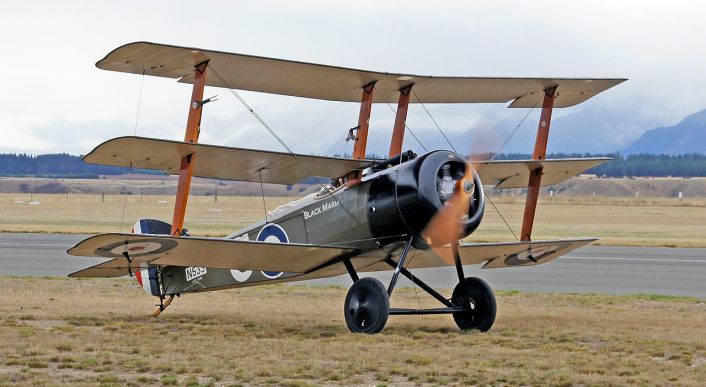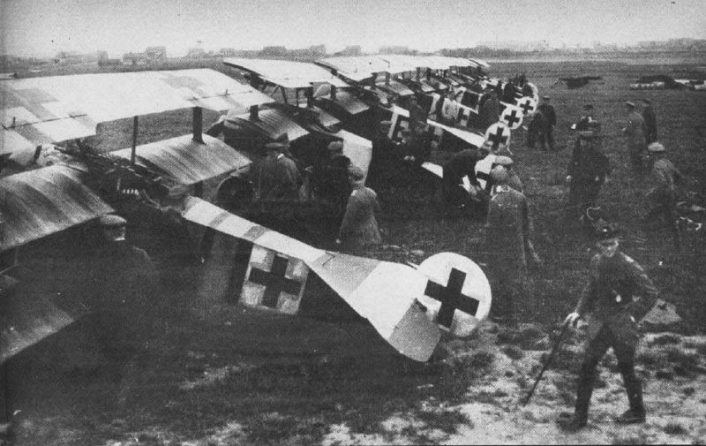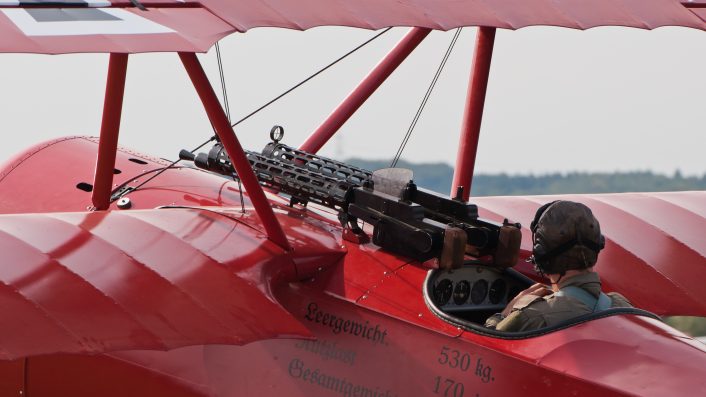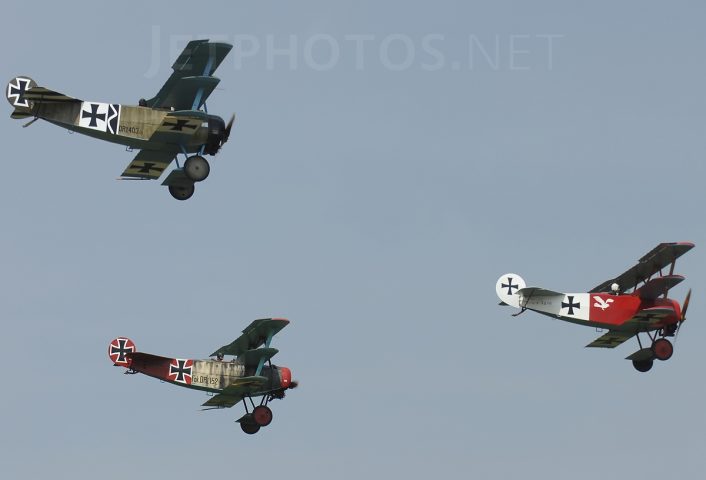
Small and agile, the Fokker Dr.1 was the German answer to the British Sopwith Triplane over European skies during the Great War, and was a favorite mount of one of history’s most famous aces.
The Triplane craze
When the British Sopwith Triplane made its debut in early 1917, its performance and rate of climb astounded the Germans. Built with three wings instead of the more common monoplane or biplane design, the third wing provided higher rates of climb and better maneuverability, along with better pilot visibility. One unit, flying with the RNAS (Royal Navy Air Service), called “B” Flight of Number 10 Naval Squadron, consisted of five black nose Triplanes, flown by Canadian pilots, and was known as “Black Flight”.
With an incredible tally of over 80 aircraft shot down with minimal losses between May and the end of July 1917, the Sopwith Triplane absolutely outperformed the aircraft it flew against, even when flying against the best German pilots in the world. Jagstaffel 11 (Jasta 11). Jasta 11 was a unit led by Manfred von Richthofen, better known as “The Red Baron”. Panic arose over the new three-wing design on the German side, and the mere sight of the Triplane stoked fear among the pilots opposed to it. The result was a scramble by the Germans to design and build their own three-plane dogfighter. This was known as the ‘Triplane Craze’.
Germany and Austria-Hungary would produce several three-plane models from different manufacturers as a result of this sudden interest and belief in the inherent superiority of the three-plane design by the Central Powers. But only one model would stand out and be produced in quantity. That aircraft would be the Fokker Dr.1.
 The plane that started the Triplane Craze, the Sopwith Triplane, pictured here in the famous black nose markings of Flight No. 10 “B”. This aircraft is a replica in the livery of Black Maria, the aircraft flown by Flight Commander Raymond Collishaw, leader of the group. (Image credit: Wikimedia Commons)
The plane that started the Triplane Craze, the Sopwith Triplane, pictured here in the famous black nose markings of Flight No. 10 “B”. This aircraft is a replica in the livery of Black Maria, the aircraft flown by Flight Commander Raymond Collishaw, leader of the group. (Image credit: Wikimedia Commons)
Meet the Breeder
Working for Germany, Dutch aircraft manufacturer Anthony Fokker It is said that the first Sopwith Triplane shot down in German occupied territory was delivered to him for study and production of a German counterpart. The first pre-production model, quickly designed by Reinhold Platz, flew in the summer of 1917.
The prototypes were called the Fokker F.1 and three were produced. Two saw operational service; one was flown by Werner Voss, the other Manfred von Richthofen and achieved his 60th victory in the aircraft. Voss was the second leading ace behind Richthofen at the time and scored his last 11 kills in the F.1. Voss was a big proponent of this type, along with other pilots who flew it. It went into production as the Fokker Dr.1 (the Dr. is the abbreviation of Dreidecker, which means three-decker).
The production model
The shape of the horizontal tail surface was changed from the prototypes and the skids were placed under the wingtips, preventing ground loop damage. The production model had a light, sleek design with no reinforcing wires and outperformed contemporary German fighters, prompting Richthofen to declare that the aircraft could “climb like a monkey and maneuver like a devil.”
Ailerons were only present on the upper wing. Its light and powerful elevators and rudder allowed for remarkable control, allowing it to make a much tighter turn and have remarkable yaw ability. A wing profile was placed between the wire-spoked and canvas-covered wheels of the chassis.
The aircraft had a wood laminate propeller made of walnut and ash wood. The laminated propeller was less prone to warping, was lighter, cheaper to produce than solid propellers, and was stronger and more flexible. The fuselage was made of a revolutionary welded tubular design covered in fabric, the wings were made of a wooden spar with ribs glued to it and also covered in fabric. The cockpit was sparse, with minimal necessary gauges and a simple metal seat.
The Dr.1 was powered by a single Oberursel Ur.II 9-cylinder rotary engine of 110 hp, which produced a maximum speed of 180-180 km/h, and the climb rate reached 10,000 feet in about 7 minutes. Considering that many aircraft of the time, including the Sopwith Triplane, took over 10 minutes, if not longer, to reach 10,000 feet, this was a significant improvement. The service ceiling was just over 6,000 meters. The aircraft was small, with a wingspan of 23′ 7″, a length of 18′ 11″, and a height of 9′ 8″. The maximum take-off weight was 1,291 pounds and the empty weight was only just over 800 pounds. The aircraft had an endurance of approximately 1 hour and 30 minutes.
 Fokker Dr.1s belonging to Jasta 26 in France. Airplanes often operated from makeshift open field bases during World War I, moving from place to place along the front lines. (Image credit: Wikimedia Commons)
Fokker Dr.1s belonging to Jasta 26 in France. Airplanes often operated from makeshift open field bases during World War I, moving from place to place along the front lines. (Image credit: Wikimedia Commons)
Fokker firepower
The Dr.1 was armed with two forward firing side-by-side LMG 08/15 “Spandau” water-cooled machine guns of Maxim design, mounted on the upper part of the forward fuselage just forward of the cockpit, firing through the propeller arc using a synchronized breaker. The belt-fed guns each had 500 rounds of ammunition stored behind the fuel tank and forward of the cockpit under the guns. They fired the 7.92mm x 57 round at a velocity of 2821 feet per second with a rate of fire of 400-500 rounds per minute. The observation range was 2,200 meters. Left and right strips were mounted on the steering column, allowing the guns to be fired separately or both fired together.
 A replica of a Fokker Dr.1 image, showing the two LMG 08/15 machine guns. It was called “Spandau” because of its production in the Spandau arsenal. It was one of Germany’s most important aircraft weapons during the war, and it was developed from versions used by ground forces. Note the front sight clearly visible on the right gun, and on the more modern instrument panel. There is a small windshield between the two guns. The proximity of the gun butts to the pilot’s head caused several injuries during rough landings. (Image credit: Wikimedia Commons)
A replica of a Fokker Dr.1 image, showing the two LMG 08/15 machine guns. It was called “Spandau” because of its production in the Spandau arsenal. It was one of Germany’s most important aircraft weapons during the war, and it was developed from versions used by ground forces. Note the front sight clearly visible on the right gun, and on the more modern instrument panel. There is a small windshield between the two guns. The proximity of the gun butts to the pilot’s head caused several injuries during rough landings. (Image credit: Wikimedia Commons)
A flying circus
Perhaps the Fokker Dr.1 wasn’t the best fighter of the Great War, but it is by far the most famous and possibly the most famous of all time, simply because of who flew it. Dubbed the ‘Flying Circus’ due to the dazzling array of bright colors and markings applied to many of their aircraft and the fact that the group traveled along the front lines and set up camp in various locations as necessary. Jagdeshwader 1 (Fighter Wing 1) was the result of the reorganization efforts of the Germans, with Jastas 4, 6, 8 and 11 being placed in the larger formation in June 1917. Manfred von Richthofen was in command.
In early 1917, Richthofen had his then aircraft, an Albatross D.III, painted a bright crimson red, and because it was so colorful it not only made it an easily recognizable target, but also inspired awe and respect and aroused a little atmosphere. fear among opponents. He scored 23 kills in the Albatross D.III, earning the nickname ‘The Red Baron’.
Some of Germany’s deadliest aces flew in the Circus, including Herman GoeringErnst Udet, Werner Voss, Hans Weiss, Kurt Wolf, Manfred’s cousin Wolfram von Richthofen, and also Manfred’s brother Lothar von Richthofen. Manfred was the leading ace of the war with 80 victories to his name.
Many of the Red Baron’s victories came in a variety of aircraft, as during the war technology accelerated and aircraft continued to evolve at a rapid pace, and frontline fighters often had short service lives. But his most famous horse is the crimson triplane we all know, the Fokker Dr.1. It would be the aircraft he preferred even after the introduction of newer and faster aircraft became available. In fact, the Red Baron would make his last flight in it, dying on April 21, 1918 while flying a Fokker Dr.1 designated 425/17.
 Artist’s rendering of the Fokker Dr.1 by Manfred von Richthofen. He was shot and killed on April 21, 1918, one day after he committed his 80th murder. Notably, the German German cross markings have been changed to the new straight pattern, the laminate propeller is clearly visible and the wing lips are visible. The tail was also painted white. To this day, controversy rages over the downing of the world’s most famous bait. (Image credit: Wikimedia Commons)
Artist’s rendering of the Fokker Dr.1 by Manfred von Richthofen. He was shot and killed on April 21, 1918, one day after he committed his 80th murder. Notably, the German German cross markings have been changed to the new straight pattern, the laminate propeller is clearly visible and the wing lips are visible. The tail was also painted white. To this day, controversy rages over the downing of the world’s most famous bait. (Image credit: Wikimedia Commons)
The wings come off
In the fall of 1917, two prominent aces, Heinrich Gontermann and Gunther Pastor, had their wings broken on Dr.1 and were killed within two days of each other. The seventeen aircraft in service at the time were grounded and production was halted to investigate the causes. It was discovered that the wings were poorly constructed, causing structural failures, and Anthony Fokker was commissioned to replace the wings of the existing aircraft and improve the construction of the aircraft produced.
The aircraft was returned to service in November and production resumed shortly afterwards. However, problems with the upper wings continued into 1918. This problem, combined with the aircraft’s difficult handling, which challenged inexperienced pilots, and the fact that the three wings increased drag and reduced speed, led to the short lifespan of this remarkable aircraft and its frontline service were decent. by the summer of 1918 it was largely over.
A total of 320 were built and the type is credited with more than 600 aerial victories. For such an iconic aircraft, original, complete Fokker Dr.1s no longer exist. One of Manfred von Richthofen’s Dr.1s was on display in the Zeughaus Museum in Berlin, but was destroyed during bombing in World War II. Now only fragments remain scattered around the world in various museums and private collections replicas of a once feared and beautiful aircraft.
 Three replica Dr.1s in flight demonstrate the variety of colors and markings found on the Dreidecker. No complete original aircraft of this type exist, but there are many replicas like this flying in museums and reminding us of the battle and chivalry in the skies of the Great War. (Image credit: Wikimedia Commons)
Three replica Dr.1s in flight demonstrate the variety of colors and markings found on the Dreidecker. No complete original aircraft of this type exist, but there are many replicas like this flying in museums and reminding us of the battle and chivalry in the skies of the Great War. (Image credit: Wikimedia Commons)